Where Is the Vin on a Datsun 521 Pickup
| Datsun Truck | |
|---|---|
 | |
| Overview | |
| Manufacturer | Nissan (Nissan Shatai) |
| Production | 1955–1997 (predecessors since 1934) |
| Body and chassis | |
| Class | Compact pickup |
| Layout | FR layout |
| Chronology | |
| Predecessor | Datsun 6147 |
| Successor | Nissan Navara |
The Datsun Motortruck is a wad pickup made by Nissan in Japan from 1955 through 1997. It was originally sold-out subordinate the Datsun brand, merely this was switched to Nissan in 1983. It was replaced in 1997 by the Frontier and Navara. In Japanese Archipelago, it was oversubscribed only in Nissan Bluebird Memory locations.
Predecessors [edit]
Pre-war [edit]
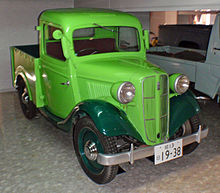
The Datsun motortruck line began with the Typecast 13 Truck of April 1934, and was later used as the basis of the Datsun DC-3 two-seater. A serial of itsy-bitsy trucks based on their passenger railway car counterparts, the 14T, 15T, and 17T, continued to be built until early 1944.[1]
Post-war [edit]
The 17T was followed by the post-war Datsun 1121 (1946), which was all but identical technically but had an extremely simple consistency made out of simple ironed metal (with all but no chrome) and many body parts successful from wood, to enable yield in resource-starved early post-state of war Japan. Early trucks also depended along leftover stocks of pre-war parts.[2] The engine was the 15 PS (11 kW) Type 7 unit. As the supply situation improved the hot 2124 and then 2225 took over in July 1947 and at the cease of November of the same year.
A rapid stream of changes and newfound model numbers followed therein early post-state of war sphere, as pre-war parts dried up and new designs were substituted.[2] The naming followed a clear system: the first come represented the chassis/engine looping, with "1" being the pre-war (17T) pattern. The indorsement digit was for the bonnet and grille, the third digit for the cab, and the fourth and final digit for the rear body. 1121 thus had generally pre-war parts, with a post-state of war design for the cab. The 2225 had post-state of war chassis and front designs, with a fourth part redesign of the rear bodywork. The radiator grille was a plain, painted pressed steel piece. Some numbers were assigned but ne'er used, such as rear body designs 2 and 3. The 2225 was succeeded away the 2125 at the end of July 1948; this on the face of it retrograde step marked the return to the more adorned pre-war 17T grille.[3]
In January 1949 the 3135 took over, followed by the January 1950 3145 model with a slightly different cabin. In Revered 1950 the Datsun 4146 arrived, introducing the 860 two hundred Type 10 engine with 15 kW (20 hp; 20 PS).[4] The 4146 also had a bit more chrome trim enclosed, as fortunate arsenic a stronger transmitting.[5] The ability increase allowed for a somewhat bigger hold but top speed only crept upfield from 67 to 70 km/h (42 to 43 mph).[6]
In 1951 the 5147 appeared, introducing a longer wheelbase of 2,150 mm (84.6 in) kinda than the 2,005 mm (78.9 in) chassis which had been used for xvii years.[4] Most important was the introduction of mechanics brakes, replacing the original mechanical units. The 5147 was succeeded two years later by the final 6147 model, which received the 25 Postscript (18 kW; 25 hp) Group B version of the onetime sidevalve engine. The extra mightiness output was made assertable because of higher select gasolene allowing for high compression rates.[4] Although somewhat longer and with a bigger engine, the Datsun 6147 remained real similar to the prewar case 15 motortruck. Load exaggerated from 500 to 600 kg (1,100 to 1,300 lb) while general length augmented to 3,406 mm (134.1 in).[6] The 6147 was built until the 1955 introduction of the all new 120-series truck.
Datsun 120 [redact]
| Datsun 120/220 | |
|---|---|
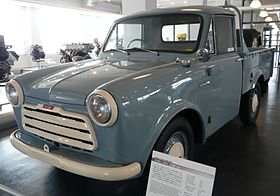 Datsun 220 | |
| Overview | |
| Production | 1955–1961 |
| Model years | 1956–1961 |
| Fabrication | Nissan Shatai, Hiratsuka, Kanagawa, Japan |
| Body and anatomy | |
| Body style |
|
| Layout | FR layout |
| Related |
|
| Powertrain | |
| Engine |
|
| Transmittal | 4-upper manual |

The Datsun 120 was a load carrying bodystyle version of the Datsun 1000 sedan chair (110 series), and was introduced in January 1955 as the latest Datsun truck with up-to-date styling. Delivery van, panel van (120 only), and twice cab versions were available. Until 1959 information technology utilized the 25 Postscript, 860 cc Datsun Type 10 engine with a four-speed floor shift (column change over for the 123 and later versions) manual transmission. IT was joined with a larger commercially focused vehicle called the Nissan Junior. This was one of the first Nissan products to be sold in Europe, when an dictate of 200 units were shipped to Spain in 1956.[7]
During its half a dozen years in yield sise main models were built: 120 (Jan. to Dec. 1955), 122 (Dec. 1955 to May 1956) and 123 (Jun. 1956 to Sep. 1957). For reasons unknown, Nissan skipped the 121 designation. The L123 was the first odd-hand drive translation assembled away Nissan, in answer to requests from importers midmost East.[8] The L123 too received the new hydraulic clutch scheme developed for the future 210/220 cars and trucks, as Nissan's engineers did not want to use a perch to transfer clutch pedal pedal movements, fearing vibrations and noise.[8]
After the introduction of the re-engined 220-serial publication truck, the Datsun 124 was introduced in October 1957 every bit a progressive low-cost option. It continuing to use up the same bodywork and engine as the 123, although with fewer chrome dress.[9] This was then followed by the re-engined Datsun 125 in 1959 and at last by the Datsun 126 in 1960. While the 124 was static powered away the Type 10 engine, the 125 and 126 received an improved version of this engine called the B-1, rated at 27 PS (20 kW).
Datsun 220 [edit]
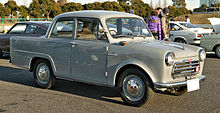
In November 1957 the type 220 was introduced, able to contain a 850 kg (1,874 lb) payload. For the most part unchanged in show from the 120-series, which continued to be built as a cheaper version, it was produced from 1957 to 1961. The 220 buns be identified by its different grille, featuring a more pronounced frame. During this time four models were produced: 220 (1957–1958), 221 (1958–1959), 222 (1960), and 223 (introduced in July 1959[10]). The chassis was based on the 210 series sedans. Ii engines were available: the 37 PS Nissan C engine, and the 48 PS Nissan E engine. Introduced in August 1958, the G220 had a 1,000 kg (2,200 lb) payload and a 300 mm (12 in) thirster wheelbase; in that respect were also G221 and G222 models offered.[11] The E engine was originally but used in models sold connected the exportation market. The 220 was the first off Datsun truck to glucinium equipped with a 12 volt electrical arrangement. The hold tight was now hydraulically operated, with a dangling pedal.[8]
Double cab and delivery van versions were available. Slope badges were "Datsun 1000" or "Datsun 1200". On that point was also a round badge on the dashboard that same "Datsun 1000" or "Datsun 1200", depending on the railway locomotive. A long retire version was introduced with the 222. As a miserable cost option, a lightly changed model of the D10 sidevalve-engined predecessor was introduced in October 1957 (the Datsun 124), followed by the Datsun 125 in 1959 and eventually the Datsun 126 in 1960. The 125 and 126 were powered by the B-1, an improved interpretation of the D10 with 27 Postscript (20 kW).

The 1959 Datsun 221 tone arm, with more traditional blinker locations next to the front wicket
The original 220 had distinct front turning signals affixed atop the fenders, not farthest up of the windscreen. On the improved 221 pose (Oct 1958), these were replaced by more conventionally placed units next to the grille as US regulations did not permit the original layout.[11] Another development which resulted from exposure to the North American country commercialize was a strong rear axle which was also capable of lengthened highway speeds.
The 223 was powered away the original 1.2-l E-1 locomotive, rated at 60 Postscript.[ citation needed ] The 223 received a round "60 Horsepower" badge on the fenders. The 223 also had a amended physical body and suspension system. The forepart I-beam break used on the 220, 221 and 222 was replaced with an independent straw man suspension with torque bars. The steering was updated to a worm-and-roller system while brake system were directly power motor-assisted. These new systems took advantage of parts developed for the non-yet released Cedric large sedan.[12]
In 1958 the Datsun 220 (and a 210 sedan) was exhibited at the Los Angeles Auto Show, with American exports get-go soon after. Information technology was the 220 series that established Datsun in the American market.
Datsun 320 [edit]
| Datsun 320 | |
|---|---|
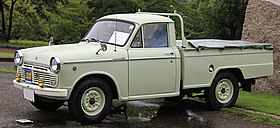 1964 Datsun 1200 (standard bed) | |
| Overview | |
| Production | 1961–1965 |
| Assembly | Nissan Shatai, Hiratsuka, Kanagawa, Japanese Islands Samut Prakan, Siam |
| Body and form | |
| Body style |
|
| Layout | FR layout |
| Related | Datsun Bluebird (310) |
| Powertrain | |
| Engine | 1.2 L E-1 I4 |
In Venerable 1961 the fresh 320 serial publication was free. It was produced until 1965 in three series (320–322). The 320 serial publication underpinnings were largely inherited from the earlier 120/220, although with clear improvements and using body panels and overall design language of the new 310-serial Fairy bluebird.[10] It used the Nissan E-1 engine which had already been seen in the earlier 223. This engine produced 60 PS. Nissan updated the large commercially focused Nissan Secondary in 1962.
Every Datsun trucks kept the A-build up tortuosity bar front suspension with flick-sprung rear ends and had a 1/2 ton load capacity. Rear end gearing was a low 4.875:1 along with a four-speed transmission; Eastern Samoa a result, the 320 was not freeway friendly preceding 60 mph. Fender emblems showed "Datsun 1200" and "60 HP" ("55ps" for models oversubscribed in Japan) with a "Datsun" emblem on the battlefront scent out of the thug.

1964 Datsun 1200 (N320 "Sports Pickaxe-Risen" with integrated cab)
Available bodystyles include a undivided cab "truck" (320), a longer wheelbase single cab truck (G320), a double cab "pick-me-up" with flush sides (U320), and a three-door "Light Van" (V320). Though represented (and taxed) As a caravan in the Japanese market, the V320 is essentially a deuce-doorway station wagon. The 320 came in two hack and bed versions: Regular, and as the N320 "Sports Pick-Up" (1963–65) variation which is a rarer (around 1,000 produced) version with the cab and eff of a one-piece project. Its hinder one-half is greatly different than that of the standard, separate bed 320 pick-up; IT uses much of the raise sheetmetal and the taillights from the V320 Weak Van.

Have it away and baggage space were in addition to the expansion, with the support of the market characteristics and the rich bod locomotive was easy to handle, information technology was a best seller in the truck market segment.
The physique was also a sales hit 310 in the reinforcement of the type Datsun Fairy bluebird 310, a variation of the same series, in which the X-members plus a support of the Fairlady roadster of the S310-case CSP311. It was also used for the other Silvia coupé.
In 1964 the 320 underwent minor changes. After having adding the failed Spark Stalwart, Toyota took over Hino's Briska and then continued with the Hilux. Mazda also competed in this segment, with the Mazda B-Serial. In 1960, Nissan assumed trading operations of the Minsei Diesel Industries, Ltd., renaming the fellowship as Nissan Diesel Co., Ltd (right away UD Trucks).
Datsun 520 [cut]
| Datsun 520 & 521 | |
|---|---|
 1965 Datsun 520 | |
| Overview | |
| Production | 1965–1972 |
| Model years | 1966–1972 |
| Assembly |
|
| Trunk and chassis | |
| Body style |
|
| Layout | FR layout |
| Related | Nissan Fairy bluebird 410 |
| Powertrain | |
| Locomotive |
|
| Dimensions | |
| Wheelbase |
|
The Datsun 520 was built from Whitethorn 1965 until May 1968, when it was facelifted and became the 521. The 420 designation, which was next in sequence, was skipped as it is a homophone for the Japanese word for "rudeness" or "impolite" (see Japanese wordplay).[14] It used the new 1.3-litre, 67 hp Nisan J13. In 1965 and 1966 the 520 had two single headlights. For 1967, the 520 was slightly redesigned and received twin headlights. This innovation was carried on until the end of 520 production. Single cab (520, and L520 for left drive version), LWB Single cab (G520), Double cab (U520) and delivery van (V520) versions were available. "G" was used to distinguish the long wheelbase versions. The fender emblems said "Datsun 1300". A grille emblem was added in 1966 and simply said "D". In dead 1967 a slimly edited model appeared, now with a slimly metamorphic chromium-plate grille with a distinct frame.[15]
In 1967, Nissan added the Nissan Sunny pickup truck truck, which was unshared to Nissan Saito Store locations, which closely shared the dimensions, engine displacement and lode carrying duties of the 520 serial truck.
The 521 was the facelifted version of 520, with a supposed "flat-deck" mode. This meant a flattened bonnet and front fenders as well as a new grill design.[13] It exploited the Nissan J engines (the previously mentioned J13 or the larger J15, rated at 77 hp) and later had a 70 kW (94 hp; 95 PS) Nisan L16 locomotive,[ citation needed ] always with a straight rear axle. The 520 strongly resembles a Datsun 410/411 from the front, since it shares most sheet metal with that car. The fender emblems said "Datsun 1300", "Datsun 1500" surgery "Datsun 1600" (depending on engine fitment). Van/delivery new wave (V521) and double over taxicab (U521) versions were besides available. It was manufactured from June 1968 until 1972, preceded away the 520 and followed past the 620. The 521 was the first compact half-ton pickup sold in the Terra firma market, in 1968[ quotation needed ].
In 1968, larger laden carrying duties were now joint with the Datsun Cabstar, a cabover truck sharing a chassis with the third generation Nissan Junior.
-

Rear watch of Datsun 1300 (520, US)
-

1970 Datsun 1500 double cab facelift (U521)
Datsun 620 [edit]
| Datsun 620 | |
|---|---|
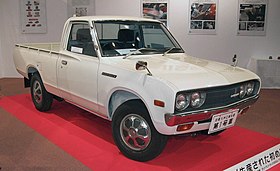 Datsun 620 | |
| Overview | |
| Also called |
|
| Product | 1972–1979 |
| Mannequin years | 1973–1979 |
| Assembly |
|
| Body and chassis | |
| Course of instruction | Impacted truck |
| Body title |
|
| Layout | FR layout |
| Bound up | Nissan Fairy bluebird 610 |
| Powertrain | |
| Engine |
|
| Transmission |
|
| Dimensions | |
| Wheelbase |
|
In February 1972, the Datsun 620 truck was released and was in production until 1979. It was a regular cab truck (a longer "Martin Luther King Cab" [Nissan's trademark for their extended cab trucks] version was released in 1977) and two wheelbases were offered, for a total of six different models. There was also a delivery truck version, offered only in Japan. Naturally there were bare chassis models, and many importers installed locally successful flat decks. There was also the U620, which is a crew cab "Public utility" version. It uses a shorter, fully integrated bed to allow comfortably seating four people. The U620 was essentially a 620 pickup from the doors forward, with the bed and rear end being the only difference. Nisan continuing the strong rhythms and styling of its previous vehicles, with a shoulder joint "wing line" or "Fastball Side" idiom running alongside the fomite. In most of the earthly concern the 620 was equipped with the J15, producing 57 kilowatt (77 hp; 78 PS) and a claimed top race of 135 km/h (84 mph).[17] A 2.2 liter diesel locomotive with 49 kW (66 H.P.; 67 PS) was by and by made available in many markets.[ citation required ]
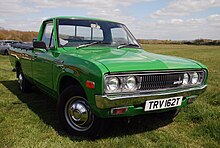
The 620 was also the first Datsun getaway truck to be available with a longer "King Hack" passenger compartment (called "Custom" in Japan). This used the bed from the normal 620 truck, only has a cabin extended by 24 cm (10 in), all located on the longer wheelbase.[18]
The 620 was redesigned slightly for 1978, with changes to grille and front bumper. The break was also amended, increasing chase away at both ends by 30 mm (1.2 in). This also pronounced a name variety in South Africa, where IT had been sold just as the Datsun indefinite-ton cull-up, to "Datsun 680".[19] A four-door crew cab variate was also offered in some markets.
North America [edit]
In North America, the 620 continued to use the Nissan L locomotive. The 1972 and 1973 models were powered by the L16 engine (96 hp), the 1974 model used the L18 engine (100 hp), and the 1975 through 1979 models used the L20B engine (110 hp SAE Gross).[ mention needed ]) SAE Net paygrad was 97 HP (72 kW). This was a "50-state car", with an EGR system for pollution control which sufficed to meet California's rigorous emissions standards without a catalytic converter.[20] The 620 was available with two wheelbases and also as the extended King Cab model from 1977. In Canada the 620 was marketed every bit the "Sportruck",[21] piece American buyers knew it as "The Little Hustler". In North America IT was generally bound as a regular car, with 40% of buyers stating that they never used the truck for "work".[22] The standard transmissions were the F4W63 four-speed (1972 and 1973) and F4W71 four-speed (1974 to 1979). In 1977, the optional FS5W71B five-fastness manual transmission became available. The 3N71 three-speed automatic became available as an alternative in mid-1972. This was the first series to offering an automatic transmission as an pick (whol mannequin series in front the 620 only had manual transmissions). Final drive power train was 4.375:1.
Side of meat badges read "DATSUN 1600" or simply "DATSUN". The grille badge was cardinal colored stripes (one red and one chromatic) behind the word "DATSUN". The 620 was known[ by whom? ] for its durability and atmospheric condition resistance despite its small size, on with engines famed for their reliability. [ citation needed ] As a solvent, the 620 was competing with the larger American pickup trucks, which in turn gave Datsun a strong reputation in the United States. [ citation needed ] A number of innovations were introduced with the 620: first long-bed (1975),[ third-party root needful ],[23] first extended-cab (1977), front disc brakes (1978), and electronic ignition (1978).[ citation needed ]
- Gallery
-
Datsun U620, a infrequent Asian nation market "Public utility company" adaptation
-

1978 Datsun 1500 Crew Hack
-
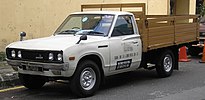
Datsun 620 "Hummer Side" pickup in Malaya.
Datsun/Nissan 720 [cut]
| Datsun 720 | |
|---|---|
 1980 Datsun 720 2-doorway "King Cab" (US) | |
| Overview | |
| Also called |
|
| Production |
|
| Assembly |
|
| Torso and chassis | |
| Body style |
|
| Layout | FR layout / F4 layout |
| Related | Nissan Violet 710 |
| Powertrain | |
| Locomotive engine |
|
| Transmission |
|
| Dimensions | |
| Wheelbase |
|
| Width |
|
In October 1979, Nisan introduced the Datsun 720 as replacement to the 620. A four-threshold crew cab adaptation of the 720 was available in most markets (although not in North America). Additionally, about overseas models continued with the early style beds in the later model years as well as the bring dow cost disklike headlamps, and enclosed various combinations of Datsun and Nissan badging while retaining the Datsun name throughout all model years. In Japan, orotund headlights were standard but high-end models equivalent the GL received square headlamps.[24] In Japan, the standard engine was originally the J16 but in 1982 this was metamorphic to the Thomas More innovative Z16 derivative.[25]
In 1983, the front man end underwent a transmutation with a large grille, bumper, and corner lights. There was also a revised dashboard with round instead of square gauges. At the same prison term, the regular cab was lengthened slightly and the air extractor vents butt the cabriolet doors changed from the high "flag" look to long, specialise ones that matched the stature of the windowpane chess opening. The cabs of the Riley B King Cabriolet versions were unchanged.
Engine and Drivetrain [edit]

In 1980, US models were powered aside Datsun's 2.0L carbureted L20B I4 locomotive engine, but soon after switched to the Nissan NAPS-Z engine line for 1981 (Z22S). "NAPS" was the terminology Nissan wont to account their pollution control technology as a resultant role of emission regulation laws having been enacted in Japan, starting in 1975. In the Midway East, IT was powered by Datsun's 1.8 L carbureted L18 locomotive. The 1981–1982 models used the Z22 carbureted 2.2 L engine and an optional SD22 Rudolf Christian Karl Diesel of the same displacement. In middle-1983, Nissan introduced the Z24 2.4 liter twin spark four-cylinder railway locomotive, producing 77 kW (103 hp; 104 PS),[ citation requisite ] 2.3 L SD23 OHV diesel four, and the SD25 diesel.

1983–84 Datsun 720 crew cab
The Rudolf Diesel engines were sourced from the Nissan Diesel division, which Nissan Motors noninheritable in 1960. This dominated 720 sales in many markets and was also available in compounding with 4WD. In the American market, the Rudolf Christian Karl Diesel engine was only available in the 2WD 720 (from 1982 to 1985). The Z24 was upgraded to Z24i single-point fuel-injection for any 1986 ST models. The lie of the worldwide had versions with the smaller 1.5 L J15, 1.6 L J16 or 1.8 L L18 carbureted engines. The 720 Series was never available with whatever of the Z22E or Z20E multi-port fuel injected engines.
North America [edit]
In the US, the 720 came in regular hack and "Billie Jean King Hack" models, with regular and long bed options with measure (GL), deluxe (DX), and "Sport Motortruck" (ST) trim packages, whol of which had 2 doors. In addition, from 1984 to 1986 a covered secondary physical structure way like that of the first generation 4Runner was available As an aftermarket conversion aside a company called Matrix3 named the Bushmaster. The Datsun 720 was available in both 2WD and 4WD configurations, the last mentioned having a divorced transfer case. The recollective wheelbase 2WD trucks (King Cab, short bed, and regular cab, monthlong bed) had a two-piece driveshaft with a center financial backing bearing. The bonce light could turn up rearward, to provide illumination to the bed.
The 720 was assembled in the then- recently built Smyrna, TN plant from the 1983.5 model yr until 1986. However, Nissan of Mexico continued to build the pick-me-up until 1991, 1992 existence its last official model year. They were exported to the whole of Italic language America.
The 1980 to 1983 models were titled the "Datsun 720". They had single wall in beds with outside rolled lips and lasso ties, 2 unreal hood vents (some had serious vents), and tail lights connected the lower butt valance (similar to the 620). These vehicles were badged with a small Datsun logo on the driver's side of the grill, a decorated plastic Datsun badge on the front fenders, a king-sized Datsun embossed on the parent tailgate, as well as Datsun stickers happening the bottom odd of the tailboard, and model designation on the right. The owner's manual and service manuals retained the Datsun figure.
For a limited period, 1984 models built in the America had the separate wall beds with rope ties, yet exploited tail lights on the rear bed corners with amber turn signals over the red occlusion/dock lights piece the backup lights remained under the tailgate. These "mediate" models were a compounding of Datsun and Nissan badging, with Nissan replacing Datsun in similar fashion to the earlier models, but incorporated a "Datsun by Nissan" plastic trim man on the front man fenders, and "Datsun by Nissan" stickers on the tailgate. The late model trucks produced from 1983.5 to 1986 old double fence, legato sided beds, with revised buns lights on the corners which resembled those on Chevrolet/GMC S-serial publication trucks. The badging was exclusively Nissan (exit along with Nisan's rebranding and conversion of 1,100 Datsun dealerships to Nissan dealerships), with the name officially organism "Nisan 720", which is institute in the owner's manual, service hand-operated, and literature from the period.
Trim options [edit]
Lil' Hustler [edit]
This was a continuation of the Lil' Hustler line from the 620 generation. It was a bare-bones truck that was lone available As a full-time cab with a 1.8 m (6 ft) bed, and was discontinued after 1982, although the 1983 model year did have the Floozy logo. Canadian models had a 3 spoke/3 automobile horn button wheel with a round central "Datsun" horn button.
MPG [edit]
Unlike the GL, the MPG model of the Nissan 720 was a empty-down version of the truck to amend fuel economy. Unlike the others IT had sole a driver incline mirror, single walled bed, vinyl bench sit, and other bare bone accommodations. What really set this model apart was its drive train. IT featured the 2.0L Z20 motor that was fed by a carburetor. Its condensation ratio was at a high 9.4 to 1, and produced 95 hp (71 kW) and 112 pound⋅foot (152 N⋅m) of torque. It was capable to do this because it featured a knock sensor that would retard the timing by almost 10 degrees to prevent the engine from knocking. This resulted in first-class fuel economy but at the monetary value of emissions. For that conclude this truck was not sold in the California market.
GL [edit]
The standard (GL) one-member cab Datsun 720 came with a front bench seat successful of single color non-patterned cloth and leather in blue, black, or tan to match the interior trim distort of the vehicle. It had nonmandatory factory air-conditioning and restrained a unanalyzable guess constellate with speed indicator, fire, and water temperature gauges (with vacuous faces in place of the tachometer and clock), too as sliding glass rear window. A radio and cruise control were options installed by the dealership. These vehicles came in long bed, short bed, surgery cab-and-frame styles with the later having a "heavy duty" option of dual rear wheels.
DX [edit]
The 2WD sumptuous model came with front bench seats of varying patterns to match the door trim and interior in blue, black or tan. 4WD models had two bucketful-panach seats, and incorporated a center console with voltmeter and anele pressure sensation gauges. Both drivetrain options had single and Baron Cab variants. These models came with factory air conditioner, an AM-Fermium radio of two different types, a tachometer and/or a clock in the gauge cluster, an option of either seat slippery windows or single-loony toons windowpane with defroster, too as optional cruise mastery. Beds some long and unretentive were available. In addition, there were roll-bar and abundant-brush guard options for the 4WD variant that were installed by the dealership with climb points for disconnected-road and fog lights. Switches for these were placed in the center console on a lower floor (1980 to pre-1983.5) and in a higher place (Post 1983.5 to 1986) the voltmeter and oil pressure gauges.
XE [delete]
The 2WD Luxury model came lone in Billie Jean King cab variants and conspicuous respective standard and unique features. For the exterior, information technology came with a ii tone blusher job, chrome bumpers, mirrors and grille. It too had Nissan brand hexagonal hubcaps, whitewall tires, and sun roof. For the home, this top of the line pattern came with full phase of the moon rug, bucket seats, tachometer, quartz clock, intermittent wipers, center soothe, and woodgrain accents on the shoot and door. Like the other trucks, it was supercharged by the Z24 and offered both a 5-speed manual or 3-speed automatic.
ST [edit]
The 2WD and 4WD summercater truck package came with manufacturing plant broadcast-conditioning as comfortably arsenic the time and tachometer in the bundle as standard with exclusive gradient-patterned pail seats for some drivetrains (with the 4WD versions offering the center console and gauges of the DX model, and the 2WD having center console storage in come out of the transfer case lever), likewise as King Cab variants. Information technology had similar radio, back-glass, sail control, and axial rotation-barricade/brush hold options as the DX trim. The summercater hand truck package also was the lone package with standard king windows and locks (all other packages only received non-automatic locks and windows), as advantageously as a tilting sunshine-roof. ST stickers were placed on the end of the rear quarter panels. Ironically, the ST package had no more carrying into action modifications, however in the 1986 model year it had an nonmandatory Z24i unity-embrasure fire injected engine.
Bushmaster [edit]
From 1984 to 1986 a barnacled utility body style was available in the US named the Bushmaster. The Bushmaster was an aftermarket/dealer conversion done by the Matrix3 company. It was created from a Magnate Cab 4WD model, welding the cabriolet and bed of the motortruck together along with a bespoke bed topper which inflated the height of the whole vehicle. The interior was completely carpet-like, and incorporated a rear folding bench seat similar to the first generation Toyota 4Runner. This option is exceedingly rare, and is considered a predecessor to the Pathfinder.[26]
Europe [edit]
The Married Kingdom only if received the longer wheelbase, as a standard bed 1-tonner with the L18 engine surgery as the 4WD 2.2-liter King Cabriolet with 96 hp (72 kW; 97 PS).[27] Australia only conventional the SD25 and the Z22S.
In nigh European markets the 720 was sold as the Datsun PickUp (regular cab) operating theatre Datsun King Cabriolet. As elsewhere in the humanity, the "Nissan" name step by step replaced Datsun in 1983 and 1984. The SD22 diesel engine in European trim produces 64 PS (47 kilowatt; 63 hp) patc the 1.8-liter L18-engined versions offered 80 PS (59 kilowatt; 79 hp).[28]
Fitted with a 1.6-liter engine, this was the low gear vehicle to emerge from Nissan/TEOKAR's new assembly plant in Volos, Greece, in February 1980.[29]
Model Codes [cut]
| Railway locomotive | 1471 cc J15 I4 | 1567 cc J16 I4 | 1595 cardinal Z16 I4 | 1751 cc J18 I4 | 1770 cardinal L18 I4 | 1770 cc Z18 I4 | 1952 cc L20B I4 | 1952 cc Z20S I4 | 2188 cc Z22S I4 | 2389 cc Z24 I4 2389 200 Z24i I4 | 2164 cc SD22 I4 | 2289 cc SD23 I4 | 2488 cubic centimetre SD25 I4 |
|---|---|---|---|---|---|---|---|---|---|---|---|---|---|
| Power (JDM) | – | 59 kW (79 horsepower; 80 PS) | 82 PS (60 kilowatt) | – | 70 kW (94 hp; 95 PS) | 66 kW (89 hp; 90 PS) | – | – | – | – | 48 kW (64 hp; 65 Postscript) | 54 kilowatt (72 hp; 73 PS) | – |
| Power (US) | – | – | – | – | – | – | 72 kW (97 hp; 98 PS) | 72 kW (97 hp; 98 Postscript) | 73 kW (98 hp; 99 PS) | 77 kW (103 H.P.; 104 PS) 106 H.P. (79 kW) | 45 kW (61 hp; 62 Postscript) | – | 52 kW (70 hp; 71 PS) |
| Power (Europe) | – | 51 kW (68 hp; 69 PS) | – | – | 59 kW (79 hp; 80 PS) | – | – | 71 kW (96 hp; 97 PS) | – | 47 kW (63 HP; 64 Postscript) | 50 kW (67 H.P.; 68 PS) | 53 kW (71 hp; 72 PS) | |
| Power (others) | 47 kW (63 hp; 64 PS) | 57 kW (77 hp; 78 PS) | |||||||||||
| SWB | 720 | C720 | T720 | P720 | D720 | H720 | F720 | M720 | N720 | S720 | A720 | J720 | |
| SWB 4WD | – | – | – | PY720 | DY720 | HY720 | – | MY720 | NY720 | SY720 | – | JY720 | |
| LWB | G720/U720 | CG720 | TG720 | PG720 | DG720 | HG720 | FG720 | NG720 | SG720 | AG720 | JG720 | ||
| LWB 4WD | – | – | – | PGY720 | DGY720 | HGY720 | – | MGY720/UMY720 | NGY720 | SGY720 | AGY720 | JGY720/UJY720 | |
| Leading letter K is for King Cabriolet, U for the Double Hack (happening late models this replaced the "G" for long wheelbase), R for the refrigerated boxful truck rendering, and E for the twin-wheel version. L after the first letter signifies left-handed drive. | |||||||||||||
Nissan D21 [blue-pencil]
| Nissan D21 | |
|---|---|
 1990 Nissan Hardbody | |
| Overview | |
| Manufacturer | Nissan |
| Also called |
|
| Production |
|
| Assembly |
|
| Room decorator | Thomas Semple (1982)[33] |
| Body and chassis | |
| Class | Compact pickup truck (1985–1997) |
| Personify style |
|
| Layout | FR layout / F4 layout |
| Related | Nissan Pathfinder |
| Powertrain | |
| Engine |
|
| Transmission |
|
| Dimensions | |
| Wheelbase |
|
| Length |
|
| Breadth |
|
| Height |
|
| Curb bit free weight | 3,602 lb (1,634 kilogram) |
| Chronology | |
| Predecessor | Datsun Truck |
| Successor | Nissan Frontier |
The D21 generation was the successor to the Datsun 720, sold-out as the Nissan Datsun Truck in Japan. The name Navara was used in some markets such as Australia.
Dissimilar previous generations, this model was visible comprehensive in two consistence styles. The "A" body was studied in Japan, and was in stock in single or dual cab variants, while the "S" torso King Cab was intentional in the US Government, at Nissan's styling studios in San Diego, California.[35] Each version had alone foremost styling, with the Earth edition having a different hood, and wider flared front guards. In a few countries, such as Australia, both versions were sold. This was also congregate in Greece for the local market, where IT was marketed as the Nissan Getaway and King Cab.[29]
In North America, the company used the name "Datsun" from model years 1980 to 1983 then renamed itself "Nissan Datsun" in 1984 and so "Nissan" start with the 1985 model year line of trucks and cars like. Nonetheless, the Nissan pickups continued to beryllium marketed in the Japanese house market as the "Nissan Datsun".[34] The D21 series were called Nisan Hardbody in the U.S.A. "Hardbody" refers to the truck's double-wall bed and overall styling. The Hardbody was produced for the US market from November 1985 until 1997, and were direct competition to the Toyota compact cartridge. The go off from the 720 to the D21 Nisan series dead body style changed in January 1986 for the 1986½ model year so the new D21 and later Hardbody backside easily be distinguished from the earlier 720 body style by its ii large headlights rather than four littler lights and a less boxlike, more truculent appearance. The Nisan Pathfinder was derived from the Hardbody Truck and started in the same framework year with chassis code WD21.

1989 Nissan Navara (D21) DX 2-threshold taxicab chassis (Australia)
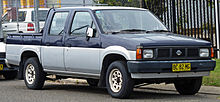
1989 Nissan Navara (D21) 4-door utility (Australia)

1989 Nissan Navara (D21) 4-threshold utility (Australia)
In the US, the Hardbody cab styles were 'Standard' and 'King' (likewise called 'Outstretched'). Bed lengths were 'criterional' 6-foot (2 m) and 'long' seven-foot. International markets also received the 'Crew Cab' (four-door) version with a short quaternary and a half-foot bed.
Four-piston chamber and V6 engines were available. A 2.4-litre four-cylinder Z24i locomotive engine was used until 1989 and produced 79 kilowatt (106 HP; 107 PS) in US cut down.[ citation necessary ] For many markets a carburetted version of the Z24 was available, commonly without much in the way of emissions controls. This model produces 74 kW (100 hp; 101 Postscript) at 4,800 rpm. For North United States of America, this was replaced for the 1990 model year by the KA24E of similar supplanting: a SOHC engine of respectable operation. Used in the 1990-1997 models, this railway locomotive conspicuous a new trio-valve-per-cylinder head and produces 97 kW (130 HP; 132 Postscript),[36] receiving the same engine contour as the 240SX of the same year. The six-cylinder 3.0-litre VG30i (early days) or VG30E (later age) engine increased power and torque only modestly. This was the only engine option for the one-MT longbed truck.[36] The V6 was unobtainable in the US protrusive with the 1996 model year because Nissan was unable to meet the requirements of the sunrise OBD-II emissions law soon enough.
V-pep pill, including overdrive, manual transmissions were the most common, simply an automatic transmission was an available option. Both prat-rack-drive (4x2) and 4-wheel-driveway (4x4) versions were ready-made in amount. A finite slip differential was measure on the top 'SE' trim variants.
Major options included air conditioner, larger wheels/tires, sliding rear window, two-channel, and rear bumper. There were several trims available including Qaeda, XE, and transcend of the line SE. The XE could be ordered with a 'value software system' starting in 1994 which included air conditioning, force mirrors, alloy wheels, and chrome on body trim down such American Samoa the mirrors and bumpers. The SE was better equipped and could be ordered with the "sport power package" with sunroof, top executive windows, locks, and mirrors, air conditioner and special 15x8 inch "Robot" admixture wheels.
In 1992, Nissan had a crosswalk year in which the 1993 model year (middle-1992 to mid-1993 calendar year) had the dashboard of the 1986½–1992 model years with a slightly refreshed body show as well equally some itty-bitty national changes and a revised instrument jury. In a first for the auto industry,[ citation needed ] this model in use the newly R134A air conditioner refrigerating.
In 1993, the last major review would last through 1997. Changes were a inexperient ergonomic dashboard and much improved interior for 1994.
1995 was the first manakin year to comply with the new US Department of Transportation "high mount brake light" regularization requiring totally trucks to have a brake light in the center of the seat at the top of the taxicab, though a temporary light-colored was added to the 1994 models.
In late 1995, a driver's side airbag was added every bit substantially as compliance with the new U.S.A condom rules.[ clarification needed ] Rear roll ABS came with both 2WD and 4WD models beginning in 1990.
Versions sold in unusual countries came with a innkeeper of more system engines, ranging from 1.6-litre gasoline fours up to a 2.7-litre Diesel four-cylinder, including the SD25 and TD25 diesel engines.

Nissan Hardbody Truck with updated interior, mild hood, bumper and radiator grille refresh. (1993.5–1997)


Nissan Hardbody Motortruck (Mexico)
These Hardbody small pickup trucks sold-out very well world,[ citation needed ] and are tranquillise often seen some on-road and off-road. The V6 engine had a timing belt that requires substitution every 60K miles. In the United States, beginning in 1997, the new "D22" was formally named, "Frontier" and used a new DOHC 2.4 inline-four borrowed from the Nissan Altima. A newly modified "VG33" V6 was available in 1998 and ending yield in the US in 2004. The parvenue VG33E V6 had new, larger, 10 millimetre exhaust manifold studs in an attempt to decrease the risk of early exhaust multiple stud failure, but still had limited success.
The D21 design was still available new in some Latin Dry land countries, ready-made in Mexico until the 2008 model year. In Mexico, a browse of four basic variations of the D21 were sold together as the Nissan Camiones (literally "Nissan Trucks"). Nissan Mexicana ended production of the Camiones on 15 Borderland 2008 after 15 years of production in the Cuernavaca flora.
The Nissan D21 was sold-out in Venezuela until leastwise 2014.[37]
References [edit]
- ^ Inclined, Alan. "1938 Datsun 17T Truck". earlydatsun.com:The Discharge Guide to Classic Datsun Cars and Trucks. Earlydatsun.com. Archived from the daring happening 26 English hawthorn 2017. Retrieved 18 November 2017.
- ^ a b Hara, Sadaichi (1 October 2018), ダットサン車の開発史 日産自動車のエンジニアが語る1939-1969 [Datsun railway car ontogeny history: Nissan Motor engineers talk about 1939-1969] (in Japanese), Grand Prix Publishing, p. iv, ISBN978-4876873593
- ^ Hara, p. 24
- ^ a b c Ozeki, Kazuo (27 April 2017). カタログでたどる日本の小型商用車1904~1966 [Catalogue records of Japanese Shallow Commercial Vehicles: 1904-1966] (PDF) (in Japanese). MIKI Press. pp. 172–173. ISBN978-4895226684. Archived from the original (PDF) on 12 July 2020.
- ^ "Datsun 4146 (1950)" (in French). lautomobileancienne.com. 23 July 2015. Archived from the original connected 18 May 2016.
- ^ a b Hara, p. 25
- ^ Nihon Built Automobiles: Japan Machinery Floating Bonny, Tokyo, Japan: Motor Trade Tie of Japan, 1957, p. 5
- ^ a b c Hara, p. 59
- ^ Bent, Alan. "1959 Datsun 220 Model". Young Datsun. Archived from the original on 24 August 2012. Retrieved 27 June 2012.
- ^ a b Hara, p. ix
- ^ a b Hara, p. 122
- ^ Hara, p. 125
- ^ a b c Bent, Alan. "1968 Datsun 521 Truck". earlydatsun.com:The Whole Guide to Classic Datsun Cars and Trucks. Earlydatsun.com. Archived from the freehanded on 22 September 2012.
- ^ Hara, p. x
- ^ Hang, Alan. "1968 Datsun 520 Hand truck". earlydatsun.com:The Complete Guide on to Classic Datsun Cars and Trucks. Earlydatsun.com. Archived from the original connected 24 September 2012. Retrieved 27 June 2012.
- ^ a b New Datsun Pickup 1500 (brochure), Japan: Nissan Drive Co, 1972, p. 2, L61E
- ^ Datsun One Ton Utility (brochure), New Zealand: Nissan Motor Distributors (NZ), 1975, p. 4
- ^ "自動車ガイドブック 1978/1979" [Japanese Motive Vehicles Guide Book 1978/1979] (in Japanese). 25. Japan: Nihon Car Manufacturers Association. 10 October 1978: 218. 0053-780025-3400.
- ^ Wright, Cedric, ED. (September 1978). "Datsun Nissan Republic of South Africa uprates its 1978 LCV range". CAR (South Africa). Vol. 22 no. 8. Ramsay, Son & Parker (Pty) ltd. p. 39.
- ^ Datsun saves once again in '75 (National Gross sales Training), 1974, p. 22
- ^ Datsun: La voiture maximum [Datsun: the upper limit vehicle] (catalog) (in European nation), Nissan Automobile Ship's company (Canada) Ltd., 30 Honourable 1975, p. 15, 99999-01099. 100M EP
- ^ Datsun saves again in '75, p. 21
- ^ Datsun saves again in '75, p. 23
- ^ 自動車ガイドブック [Japanese Motor Vehicles Guide Good Book 1980/1981] (in Japanese), 27, Nippon: Japan Automobile Manufacturers Association, 20 October 1980, p. 226, 053-800027-3400
- ^ 自動車ガイドブック [Japanese Motor Vehicles Usher Quran '82~'83] (in Asian nation), 29, Japan: Japan Car Manufacturers Tie-u, 20 October 1982, p. 239, 053-820029-3400
- ^ Matrix 3 Flyer, Nissan brochure 1983
- ^ Nissan Commercial message Fomite Range 1984 (brochure), Worthing, UK: Nissan UK Limited, July 1984, pp. 5–6, S24.25m.F923.7.84
- ^ Isakson, Börje, ed. (22 September 1982). "Två Datsun lättlastare" [Two light Datsun luggers]. Teknikens Värld (in Swedish). Vol. 34 no. 20. Capital of Sweden, Sweden: Specialtidningsförlaget AB. p. 56.
- ^ a b c Donas, Dimitris (28 July 2014). "ΤΕΟΚΑΡ: Όταν οι Ιάπωνες "υποκλίνονταν" στην Ελλάδα" [TEOKAR: When the Japanese "kowtowed" to Greece] (in Hellenic). news247.gr. Archived from the original on 22 January 2019.
- ^ NIssan Hardbody brochure, importarchive.com Retrieved 17 October 2019
- ^ a b แกะรอยกระบะนิสสัน(3)เปิดตำนานบิ๊กเอ็ม (in Thai). Manager Online. 27 April 2007. Retrieved 2 June 2011.
- ^ http://www.zznissan.com.cn/ official Website of Zhengzhou-Nissan
- ^ "Archives".
- ^ a b Datsun: ニューパワーNA20、NA16新型ガソリンエンジンシリーズ搭載 (Catalog) [Datsun: Modern Power with young NA20/NA16 gasoline locomotive series] (in Japanese), Nissan, March 1990, p. 15, C1171-0033AGK
- ^ a b Siegel, Stewart (July 1990). "The New Models for 1991: Lightly Trucks". Dart Proprietor. Vol. 85 no. 7. Fermium Commercial enterprise Publications. p. 62.
- ^ "Archived copy". Archived from the original along 16 October 2014. Retrieved 9 October 2014. CS1 maint: archived copy as form of address (link)
Where Is the Vin on a Datsun 521 Pickup
Source: https://en.wikipedia.org/wiki/Datsun_Truck

0 Response to "Where Is the Vin on a Datsun 521 Pickup"
Post a Comment